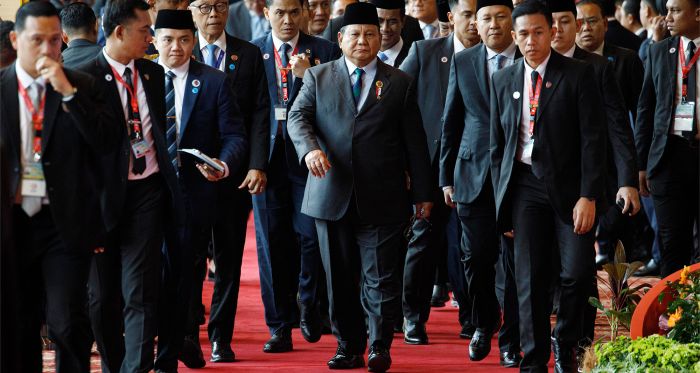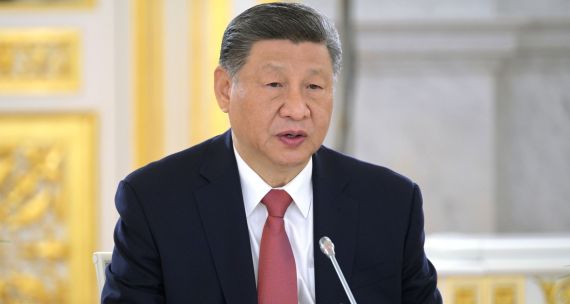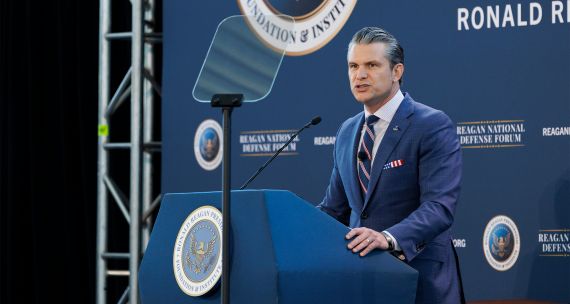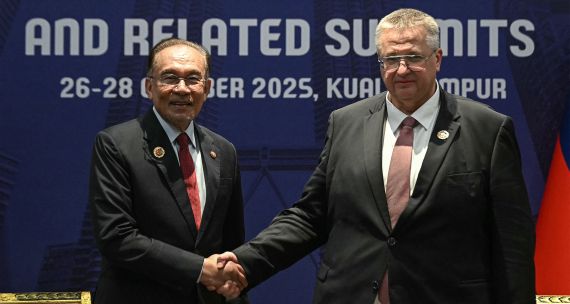Alors que l’Indonésie cherche à moderniser son économie, attirer les investissements étrangers et élargir sa base industrielle, le pays doit trouver un équilibre délicat entre la Chine et les États-Unis, ses deux grands partenaires commerciaux.
Jakarta a lancé des pourparlers commerciaux officiels avec Washington à la mi-avril, offrant une série de concessions commerciales visant à atténuer les tensions dans le sillage des tarifs réciproques, annoncés le 2 avril lors de sa « journée de libération ». Le 7 juillet, l’administration Trump a annoncé que les tarifs imposés sur l’Indonésie, au taux précédemment déclaré de 32%, entreront en vigueur le 1er août. Ils représentent un risque sérieux pour les secteurs tournés vers l’exportation, particulièrement les industries automobile, textile et de la chaussure.
À mesure que l’Indonésie navigue ses relations commerciales avec les États-Unis, le pays doit aussi se montrer prudent avec Beijing, avec qui les liens économiques dépassent largement le commerce, comprenant des investissements majeurs dans des projets d’infrastructure, d’énergie et de développement. Pour le Canada, ces dynamiques changeantes soulignent l’importance de la diversification économique et offrent des opportunités opportunes pour renforcer les liens avec la plus grande démocratie et la plus grande population ainsi que la plus grande économie d’Asie du Sud-Est, notamment dans les domaines des minéraux critiques, de l’énergie propre et du commerce numérique.
Quelle est l’exposition commerciale de l’Indonésie aux États-Unis par rapport à la Chine ?
Le commerce indonésien est de plus en plus structuré autour de liens économiques croissants avec la Chine, même si le pays maintient un engagement commercial important — quoique plus restreint — avec les États-Unis en 2024. Cette année-là, le commerce entre la Chine et l’Indonésie a dépassé 188 G$ CA, consacrant la Chine comme premier partenaire commercial de l’Indonésie : une tendance qui persiste depuis plus d’une décennie. En 2024, les échanges avec la Chine représentent environ 27 % du commerce extérieur indonésien, portés par des exportations de ressources naturelles d’une valeur de 85,4 G$ CA (notamment charbon, nickel, huile de palme et gaz naturel) et des importations s’élevant à 99,4 G$ CA. La majorité des importations chinoises vers l’Indonésie sont des produits finis : machines, équipements électroniques et biens industriels essentiels à la production et à l’infrastructure nationales.
En comparaison, les échanges commerciaux avec les États-Unis se sont établis à environ 53 G$ CA en 2024, les États-Unis demeurant un marché clé pour les exportations indonésiennes à forte intensité de main-d’œuvre, comme les textiles, la chaussure, l’électronique et l’ameublement.
Au-delà des échanges de biens, les liens économiques de l’Indonésie avec la Chine incluent des investissements majeurs dans l’extraction de ressources, le développement d’infrastructures et l’innovation numérique. La Chine est également un investisseur nettement plus actif : entre janvier et septembre 2024, les entreprises chinoises ont investi 7,9 G$ CA en Indonésie, soit plus du double des investissements américains au cours de la même période. Globalement, de 2019 au premier trimestre de 2024, les investissements chinois ont atteint 41,3 G$ CA répartis sur 21 000 projets à travers le pays.
Cette divergence, tant commerciale qu’en matière d’investissements, souligne une asymétrie structurelle. La Chine multiplie les engagements en capital et renforce la coopération industrielle, tandis que les États-Unis, malgré la valeur élevée de leur marché, conservent une relation essentiellement transactionnelle.
Comment l’Indonésie a‑t‑elle répondu aux pressions commerciales des États‑Unis ?
Bien que l’administration américaine ait exempté certains produits indonésiens des tarifs douaniers — notamment les minéraux critiques et les composants électroniques — Jakarta s’attend toujours à des perturbations considérables dans l’ensemble de ses industries tournées vers l’exportation, particulièrement dans les secteurs de l’automobile, du textile et de la chaussure.
Les États‑Unis et l’Indonésie ont tenu des discussions formelles sur le commerce du 16 au 23 avril 2025, durant lesquelles Jakarta a cherché à renégocier plusieurs catégories d’exportations clés, en particulier des produits à forte intensité de main‑d’œuvre, dont la chaussure, le textile et les fruits de mer. Les deux parties sont convenues d’une période de négociation de soixante jours pour s’attaquer aux enjeux clés, notamment les barrières non tarifaires et le commerce numérique. Les États‑Unis ont critiqué le système de paiement indonésien, connu sous le nom de Quick Response Code Indonesia Standard, le qualifiant de barrière au commerce limitant l’accès des parties prenantes internationales au marché des paiements numériques. En juin, les deux pays ont tenu une deuxième ronde de négociations, au cours de laquelle Jakarta a approuvé les propositions américaines relatives aux tarifs douaniers et aux barrières commerciales, ce qui signalerait un progrès vers un accord commercial plus large.
Une autre barrière au commerce mentionnée par le négociateur en chef des États-Unis était la politique de contenu local nécessitant qu’un certain pourcentage de composants dans des produits ou services spécifiques soit fourni localement. Parmi les concessions commerciales annoncées par l’Indonésie, une entente prévoit de réduire ses exigences en matière de contenu local pour l’approvisionnement gouvernemental, passant de 40% à 25% pour certains produits. Les ministères et organismes publics seront autorisés à se procurer des biens contenant moins de 25% de contenu local dans les cas d’approvisionnement limité et pourront importer des produits non disponibles localement.
L’Indonésie a également indiqué qu’elle œuvrera pour réduire son déficit commercial de 25 G$ CA avec les États-Unis, notamment par une hausse considérable des importations de pétrole et de gaz de pétrole liquéfié (GPL) en provenance des États-Unis, ce qui représenterait 14 G$ CA en nouvelles commandes d’énergie. Le pays s’apprête à signer un accord de 46 G$ CA avec les États-Unis, qui permettrait à l’Indonésie d’importer davantage de blé, maïs, soya, coton et énergie des États-Unis.
Cependant, comme beaucoup d’autres pays d’Asie du Sud-Est, l’Indonésie devra peser avec soin les concessions supplémentaires qu’elle pourrait consentir pour accommoder les intérêts des États-Unis.s Washington s’est régulièrement exprimé sur ses inquiétudes concernant les politiques industrielles indonésiennes, particulièrement ses règles de contenu local et l'interdiction des exportations de minéraux critiques tels que le cuivre, la bauxite et le nickel. De plus, les responsables américains se méfient de l’influence croissante des entreprises chinoises dans le secteur minier indonésien. En 2023, l’Indonésie s’est retrouvée détentrice de 27% de la production mondiale de nickel raffiné, un composant essentiel pour les batteries de véhicules électriques, et devrait produire 44% d’ici la fin de la décennie. Environ 75% du raffinage du nickel indonésien est supposément géré par des sociétés écran chinoises.
Quelles sont les opportunités et les risques pour l’Indonésie d’un rapprochement commercial avec la Chine ?
D’une part, les investissements chinois ont été essentiels pour les principaux projets d’infrastructures en Indonésie, notamment les 10,2 G$ CA investis dans la ligne ferroviaire à grande vitesse Jakarta–Bandung, dont les opérations commerciales ont débuté en octobre 2023, dans le cadre de la nouvelle Route de la soie chinoise. Parmi les autres investissements importants figurent les 885,8 M$ CA pour le parc industriel de Morowali, ainsi que plus de 6,4 G$ CA de financements continus pour la nouvelle capitale indonésienne, Nusantara, portant sur le logement, les transports, les installations énergétiques et le développement des infrastructures.
D’autre part, si ces investissements ont accéléré le développement économique et industriel, ils ont aussi suscité des inquiétudes. C’est notamment le cas pour l’industrie du traitement du nickel en Indonésie, dans laquelle un nombre restreint d’entreprises chinoises détient environ les trois quarts des principales fonderies et entreprises conjointes. La forte dépendance du secteur à l’énergie thermique au charbon a également fait l’objet de critiques internationales en raison de son impact négatif sur l’environnement, incluant les émissions de gaz à effet de serre, la pollution de l’air et de l’eau, ainsi que la dégradation des écosystèmes locaux. Par ailleurs, les critiques évoquent des conflits liés à la main-d’œuvre impliquant des travailleurs chinois, ainsi que des craintes liées à la dépendance à l’endettement, qui s’élevait à environ 37 G$ en novembre 2023.
Plus généralement, l’élite indonésienne s’inquiète qu’une puissance mondiale, particulièrement une ayant des intérêts contestés en mer de Chine méridionale, puisse jouer un rôle aussi dominant dans l’économie nationale. Conséquemment, malgré des liens diplomatiques favorables entre les deux pays, l’Indonésie n’a pas hésité à s’opposer à certaines actions chinoises. Par exemple, Jakarta a régulièrement rejeté les revendications générales sur la mer de Chine méridionale et condamné la construction d’avant-postes militaires dans les îles Natuna du Nord, situées dans la zone économique exclusive indonésienne. Cette posture met en exergue les efforts de Jakarta pour défendre sa souveraineté sans provoquer directement son plus grand partenaire commercial.
L’Indonésie poursuit cette approche équilibrée sous la présidence de Prabowo Subianto. Sa doctrine « mille amis, nul ennemi » met en lumière une diplomatie pluriverselle, cultivant des liens économiques aussi bien avec la Chine qu’avec les États-Unis, sans s’aligner exclusivement sur une seule puissance mondiale. Cette stratégie permet à Jakarta de maintenir ses relations économiques avec les États-Unis tout en conservant son autonomie, une posture qui pourrait devenir de plus en plus difficile à tenir à mesure que les rivalités géopolitiques s’intensifient.
Quelles alternatives pour l’Indonésie ?
Afin d’avoir plus de manœuvrabilité, l’Indonésie cherche à cultiver des alternatives autres que les États-Unis et la Chine. Membre fondateur de l’Association des nations de l’Asie du Sud-Est (ANASE), Jakarta soutient une intégration régionale plus large à travers des mécanismes tels que la zone de libre-échange de l'ANASE et le Partenariat économique régional global (RCEP).
Au-delà de son voisinage immédiat, l’Indonésie développe également ses partenariats économiques avec le Japon, la Corée du Sud, l’Inde, l’Union européenne et les pays du Golfe. Par exemple, en 2023, le Japon était le deuxième grand investisseur et un partenaire clé dans les secteurs de l’énergie, des transports et de la transformation énergétique. Par ailleurs, les négociations pour conclure un accord de libre-échange entre l’Indonésie et l’Union européenne se poursuivent, malgré des divergences concernant l’huile de palme et les normes de durabilité. Simultanément, l’Inde émerge comme un acheteur majeur du charbon et de l’huile de palme indonésiens, le commerce bilatéral ayant dépassé 53 G$ CA en 2023, avec des prévisions d’atteindre 70 G$ CA en 2025.
La diversification, bien qu’impérative, n’est pas sans défis. Plusieurs de ces partenaires alternatifs imposent des exigences de durabilité et des réglementations strictes. De plus, la coopération intra-ANASE est ralentie par des fragmentations institutionnelles et la compétition entre membres. À titre d’exemple, chaque pays sud-asiatique impose des réglementations internes spécifiques sur les projets énergétiques, incluant des normes de durabilité et des conditions pour les investissements, ce qui rend la collaboration sur des projets énergétiques transfrontaliers particulièrement complexe.
Toutefois, l’Indonésie entend mettre en place ce que ses dirigeants appellent une architecture économique à multiples alignements, où la flexibilité est maximisée, la dépendance à un seul pays minimisée, et les intérêts nationaux protégés.
Quelles opportunités pour le Canada ?
Tandis que Jakarta envisage d’accroître ses liens économiques au‑delà des États‑Unis et de la Chine, le pays priorise les partenaires qui respectent son autonomie stratégique, contribuent à son développement économique et constituent des alternatives crédibles à la fois à Washington et à Beijing.
Le commerce bilatéral entre l’Indonésie et le Canada demeure modeste, autour de 5,1 G$ CA en 2023. Cependant, il existe un fort potentiel de croissance, particulièrement dans les domaines des minéraux critiques, des technologies agricoles, des énergies propres et de l’éducation. Alors qu’Ottawa cherche à mettre en œuvre sa Stratégie du Canada pour l’Indo-Pacifique et à approfondir son engagement économique en Asie, l’Indonésie se distingue par sa volonté et sa trajectoire de croissance.
Pour atteindre ce potentiel, les deux pays ont conclu un Accord de partenariat économique global (APEG) en 2024. Cet accord vise à faciliter le commerce des biens et des services, à améliorer l’accès aux marchés pour les entreprises et à promouvoir des pratiques d’investissement responsables entre le Canada et l’Indonésie. En décembre 2024, le Canada a dirigé une mission commerciale en Indonésie,rassemblant plus de 300 représentants canadiens de secteurs tels que l’agriculture, les énergies propres et les infrastructures, afin de s’engager directement avec les entreprises indonésiennes.
De plus, l’expertise du Canada en exploitation minière durable s’aligne avec les objectifs de l’Indonésie pour devenir un acteur clé dans les minéraux critiques et l’industrie des véhicules électriques. Les entreprises canadiennes pourraient également contribuer à la sécurité alimentaire en Indonésie et aux objectifs de résilience climatique par le soutien à l’agriculture de précision, la gestion de la ressource en eau et la biotechnologie. En enseignement supérieur, le Canada demeure une destination attrayante pour les étudiants. Les échanges académiques bilatéraux pourraient être renforcés par la recherche conjointe en technologies vertes et en politiques publiques.
Par ailleurs, l’Indonésie a soumis sa candidature pour rejoindre l’Accord de partenariat transpacifique global et progressiste (PTPGP), dont le Canada est membre fondateur. Le rôle du Canada dans la définition des normes au sein du PTPGP, ainsi que son leadership en commerce numérique et en croissance inclusive, lui permettent de se positionner comme un partenaire estimable pour la transformation économique indonésienne. De surcroît, des négociations continues pour un accord de libre-échange Canada-ANASE fourniraient une plateforme plus large pour un engagement structuré entre le Canada et la région.
• Édité par Vina Nadjibulla, vice-présidente de la recherche et de la stratégie, et Ted Fraser, rédacteur en chef à la FAP Canada






